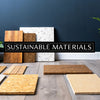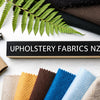Top 7 Fabric for Curtain Ideas in 2025

Elevate Your Windows with Exquisite Curtain Fabrics
Choosing the right fabric for curtain design dramatically impacts a room's feel. This curated list of top 7 curtain fabrics will help you find the perfect material for your needs, whether you’re an interior designer working on a commercial project in Auckland or a homeowner updating your villa in Wellington. From luxurious velvet to breezy linen, discover the ideal fabric for curtain projects. We'll cover cotton, linen, velvet, silk, polyester, lace, and blackout fabrics, highlighting key characteristics to inform your choices for creating beautiful and functional window treatments.
1. Cotton
Cotton is a natural, plant-based fiber that makes a popular choice for fabric for curtain creation in NZ and Australia. Its popularity stems from its soft texture, natural appearance, and excellent draping qualities. From lightweight voiles that offer a gentle diffusion of light to heavier duck cloths providing more privacy, cotton’s versatility makes it suitable for various window treatments across different room styles. This breathability makes it perfect for warmer climates like New Zealand, contributing to a fresh and airy feel in any room.
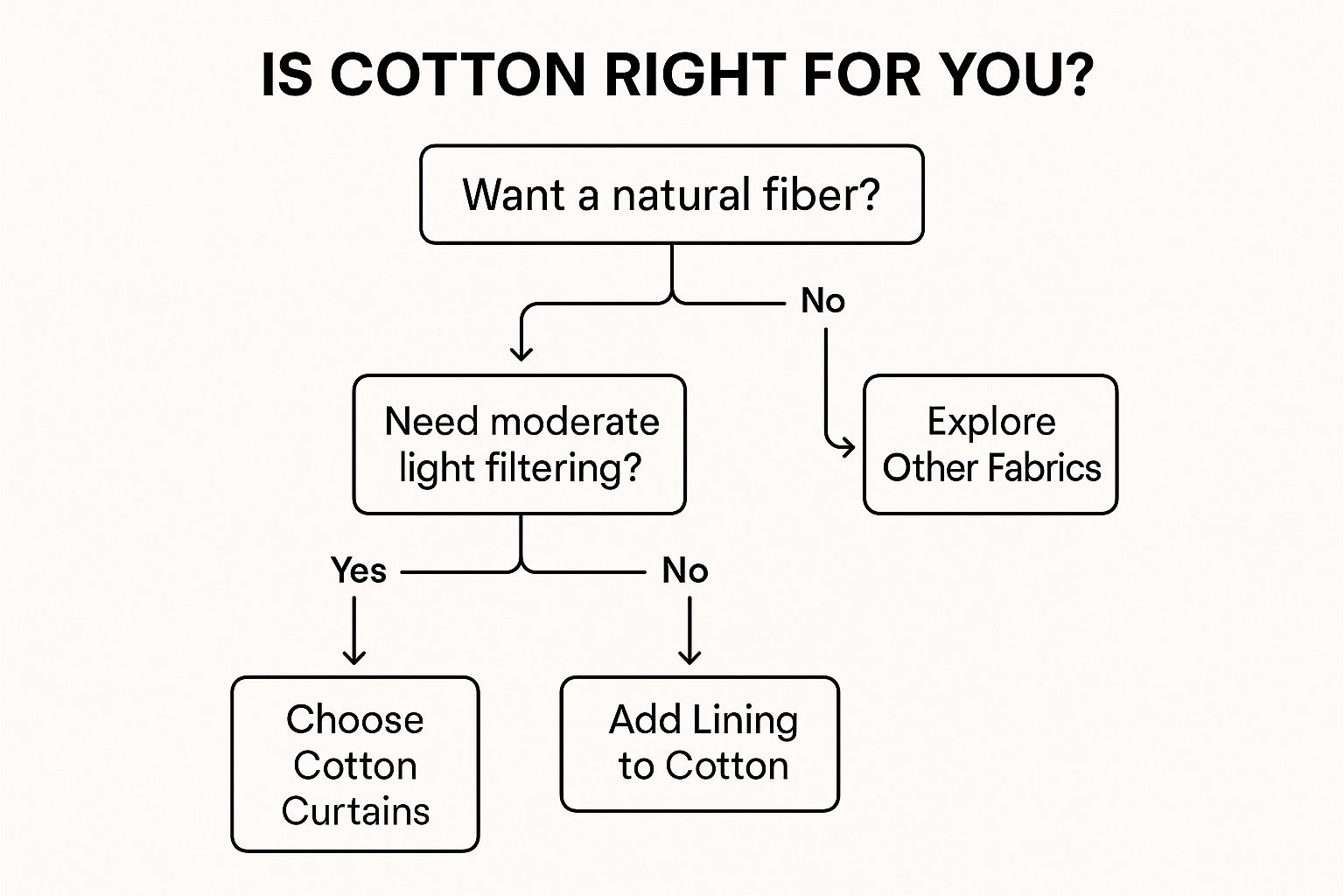
The infographic above presents a decision tree to help you choose the right cotton fabric for your curtains. It visualizes the key considerations when selecting cotton fabric, starting with desired light filtration and moving through factors like budget, maintenance preferences, and style.
Cotton's inherent breathability makes it perfect for fabric for curtain applications, allowing for good air circulation. Its natural fibers are also hypoallergenic, making it an excellent choice for sensitive individuals. This environmentally friendly material is readily available in numerous weaves and textures, from sheer muslins to heavier canvas, giving designers and DIY enthusiasts a wide range of options. Its easy dyeability allows for a spectrum of colour choices to match any interior décor. Popular brands like John Lewis, IKEA (with their RITVA range), and Pottery Barn offer a wide selection of ready-made cotton curtains, demonstrating the fabric's widespread appeal. For New Zealand homeowners, local suppliers also stock various cotton fabric options suitable for custom-made curtains.
Features: Natural fiber, Breathable, Easily dyed, Versatile weight options, Good draping quality
Pros: Environmentally friendly, Hypoallergenic, Easy to clean and maintain, Available in many weaves and textures, Moderate light-filtering ability
Cons: Prone to wrinkling, May shrink after washing, Less insulating than heavier fabrics, Can fade with prolonged sun exposure, Not naturally flame-resistant
The decision tree helps navigate the selection process by first determining the level of light control needed. From there, it guides you through considerations like budget and ease of care. For example, if high light filtration is a priority, the chart directs you towards heavier cotton fabrics like canvas or twill; if budget is a concern, it highlights more affordable options like muslin or percale.
Tips for Using Cotton Fabric for Curtains:
- Pre-wash: Always pre-wash cotton fabric before making curtains to account for potential shrinkage.
- Drying: Line drying is recommended to maintain the shape and drape of your cotton curtains.
- Privacy: Opt for tighter weaves like twill or canvas for increased privacy.
- Insulation & Light Blocking: Adding a lining to your cotton curtains can significantly improve insulation and light-blocking capabilities.
- Durability: Consider cotton blends with linen or polyester for added durability and wrinkle resistance.
Cotton's versatility and widespread availability make it a staple for interior designers, architects, and DIY home decorators alike. From eco-conscious homeowners seeking sustainable options to commercial property developers looking for cost-effective solutions, cotton offers a range of benefits. Its use has been popularized by prominent home decor brands like Martha Stewart Home Collection, Crate & Barrel, West Elm, and Restoration Hardware, further solidifying its position as a leading choice for curtain fabric. Whether you're fitting out a restaurant in Auckland or updating your living room in Wellington, cotton fabric for curtains is a versatile and stylish choice.
2. Linen
Linen is a premium natural fabric woven from the flax plant, making it an excellent choice for curtains in NZ homes and businesses. If you’re looking for fabric for curtain solutions that offer both beauty and durability, linen deserves serious consideration. Its distinctive textural appearance, exceptional durability, and inherent elegance make it a favourite amongst interior designers, architects, and discerning homeowners alike. Learn more about Linen and its sustainable qualities.
This fabric offers a unique combination of strength, breathability, and a luxurious drape. The characteristic slubs – those slight variations in the weave – add visual depth and a touch of casual elegance to any space. Whether you're aiming for a relaxed, sophisticated aesthetic in your living room or a breezy, coastal vibe in your bedroom, linen curtains can elevate the atmosphere.
Features and Benefits:
Linen's appeal extends beyond its aesthetic charm:
- Textured Appearance with Natural Slubs: The unique slubbed texture adds visual interest and dimension, making it a popular choice for those seeking a less formal, more organic feel.
- Strong and Durable Fibres: Linen is known for its resilience and longevity, meaning your curtains will stand the test of time.
- Highly Breathable: Linen's breathability allows for excellent airflow, creating a comfortable and airy environment. This is particularly beneficial in the warmer months, helping to keep rooms cool and fresh.
- Excellent Draping Quality: Linen falls beautifully, creating elegant folds and a natural, flowing appearance.
- Naturally Hypoallergenic: A boon for allergy sufferers, linen is naturally resistant to dust mites and other common allergens.
Pros and Cons:
While linen offers numerous advantages, it's essential to be aware of its potential drawbacks before making a decision:
Pros:
- Gets softer with each wash: Unlike many fabrics that degrade over time, linen actually improves with age, becoming softer and more supple with every wash.
- Exceptionally long-lasting: Its inherent durability ensures that linen curtains will remain a beautiful investment for years to come.
- Naturally resistant to moths and bacteria: This inherent resistance adds to linen's longevity and makes it a hygienic choice.
- Creates an effortlessly elegant look: Linen possesses a natural elegance that effortlessly elevates any interior.
- Environmentally sustainable: As a natural and biodegradable fibre, linen is a responsible choice for eco-conscious consumers.
Cons:
- Expensive compared to other natural fabrics: Linen's premium quality comes at a higher price point.
- Wrinkles easily: While some embrace the wrinkled look as part of linen's charm, others may find it less desirable.
- Can be stiff when new: New linen can feel somewhat stiff, but it softens considerably with washing.
- Limited insulation properties: Linen is not the best choice for insulating against cold or noise.
- May require professional cleaning: While some linen can be machine washed, certain types may benefit from professional cleaning.
Examples and Inspiration:
For inspiration, look to brands like Restoration Hardware's Belgian linen curtains, Parachute linen window panels, and West Elm's European flax linen curtains. These examples demonstrate the diverse applications and styling possibilities of linen. In the NZ context, think about incorporating linen into bachs, villas, and modern homes for a touch of understated luxury.
Tips for Using Linen Curtains:
- Embrace the natural wrinkles for casual elegance: Linen’s inherent wrinkles contribute to its relaxed, informal appeal.
- Use linen-cotton blends for less wrinkling: If you prefer a less wrinkled look, opt for a linen-cotton blend.
- Choose heavier weights for better draping: Heavier weight linen offers a more luxurious drape and better light control.
- Install with rings or grommets to showcase the natural fall: Rings or grommets allow the fabric to hang gracefully and enhance its natural beauty.
- Allow extra length for potential shrinkage: Keep in mind that linen can shrink slightly after the first wash.
Popularised By:
Brands like Pottery Barn, Zara Home, H&M Home, Cultiver, and Rough Linen have all contributed to the resurgence in popularity of linen for home furnishings. Their influence has helped to cement linen's status as a stylish and sustainable choice for contemporary interiors.
Linen offers a timeless elegance and durability that few other fabrics can match, making it a worthy investment for those seeking both style and substance in their fabric for curtain choices.
3. Velvet
Velvet earns its spot on this list of curtain fabrics for its undeniable luxurious appeal and impressive functionality. This plush pile fabric, characterized by its soft, dense surface, is created through a specialized weaving process that results in a raised, textured finish. This unique construction gives velvet curtains a rich, opulent appearance, adding instant warmth and sophistication to any space. They are a superb choice of fabric for curtain projects seeking to create a dramatic and polished aesthetic. Beyond its visual appeal, velvet excels at blocking light and providing insulation, making it a practical choice for bedrooms, living rooms, and dining areas.
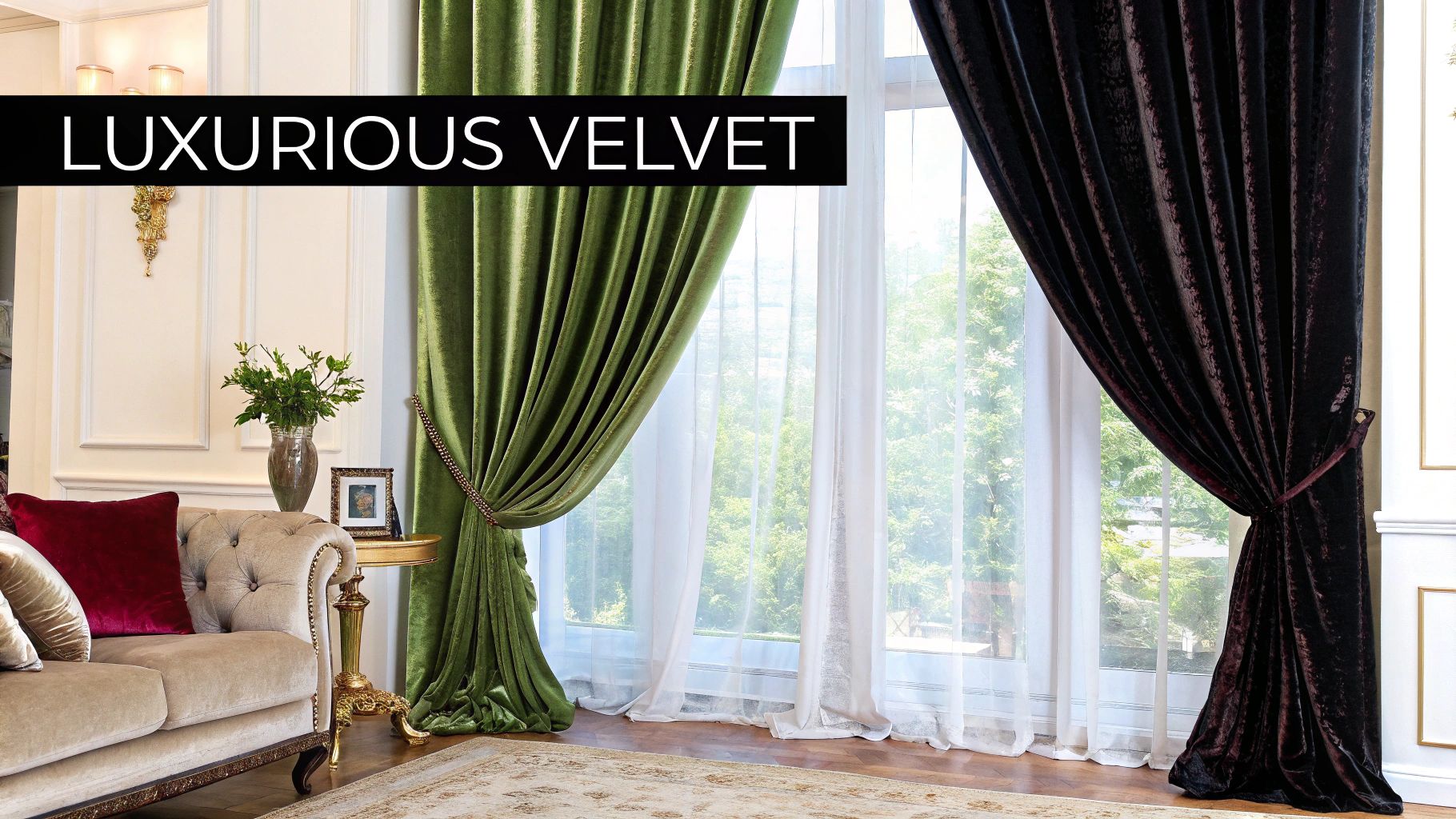
The dense, heavy construction of velvet contributes to its excellent light-blocking and sound-absorbing properties, making it a popular fabric for curtain solutions in spaces where privacy and noise reduction are desired. This makes velvet an especially suitable choice for New Zealand homes, where managing both warmth and light can be crucial. Its rich colour saturation further enhances its luxurious feel, allowing for bold design statements. Think deep jewel tones for a classic look, or softer pastels for a more contemporary feel. Popularized by designers like Kelly Wearstler and Jonathan Adler, and featured in stores like RH (Restoration Hardware), Anthropologie, and Z Gallerie, velvet remains a timeless and elegant fabric for curtain applications. You can find inspiring velvet curtain panels from retailers such as Pottery Barn, West Elm, and Anthropologie.
Features:
- Plush, soft pile surface
- Dense, heavy construction
- Rich colour saturation
- Excellent light-blocking ability
- Superior sound absorption
Pros:
- Provides excellent insulation, ideal for New Zealand's variable climate
- Creates acoustic dampening, beneficial in busy environments
- Adds luxurious texture and visual depth
- Hangs with beautiful, elegant folds
- Makes a bold design statement
Cons:
- Collects dust easily, requiring regular maintenance
- Typically requires professional cleaning
- Can be heavy on curtain rods, necessitating sturdy hardware
- Vulnerable to crushing and flattening
- Higher maintenance than other fabrics
Tips for using velvet fabric for curtain projects:
- Use sturdy curtain rods and hardware to support the weight of velvet curtains.
- Avoid using velvet in high-humidity rooms like bathrooms, as moisture can damage the fabric.
- Vacuum velvet curtains regularly with a brush attachment to remove dust and maintain their plush texture.
- Choose synthetic velvet for easier maintenance and cleaning.
- Consider adding a blackout lining for complete light blocking, particularly beneficial in bedrooms.
Learn more about Velvet for insights into current trends and styling tips. Whether you're an interior designer working on a high-end project, an eco-conscious homeowner looking to improve insulation, or a DIY enthusiast seeking to elevate your space, velvet provides a luxurious and functional fabric for curtain creations. Its unique properties make it a worthwhile investment for those seeking both style and performance in their window treatments.
4. Silk
Silk, a luxurious natural protein fiber produced by silkworms, earns its place on this list of curtain fabrics for its unparalleled elegance and luminous sheen. If you're looking for fabric for curtains that will add a touch of opulence to your New Zealand home or commercial space, silk deserves serious consideration. It offers a unique combination of beauty and functionality, although it's essential to understand its specific care requirements.
Silk works beautifully as a curtain material due to its natural luster, which catches and reflects light, creating a stunning visual impact. The fabric's fine, smooth texture and rich color absorption further enhance its luxurious appeal. Its lightweight nature allows for excellent draping, contributing to a graceful and flowing appearance. This makes it particularly suitable for formal spaces and upscale interior designs where a sophisticated aesthetic is desired. Imagine the shimmer of Jim Thompson Thai silk curtains gracing a dining room, or the artistic flair of Fortuny hand-printed silk drapes in a lounge. Designers like Thomas O'Brien, de Le Cuona, Rubelli, and Schumacher have all recognized and popularized the use of silk in high-end interiors.
Features and Benefits:
- Natural luminous sheen: Silk possesses a unique shimmer that adds depth and richness to any room. This sheen beautifully diffuses light, creating a soft and inviting ambiance.
- Lightweight with excellent drape: Silk’s lightweight nature allows for elegant folds and a flowing drape, perfect for creating a sense of grandeur.
- Exceptional color depth: Silk absorbs dyes exceptionally well, resulting in rich, vibrant hues that elevate the overall aesthetic.
- Fine, smooth texture: The smooth texture of silk adds to its luxurious feel and contributes to its beautiful drape.
- Natural temperature-regulating properties: Silk can help to insulate a room, keeping it cool in summer and warm in winter. This can be particularly beneficial in New Zealand's variable climate.
- Hypoallergenic material: A benefit for allergy sufferers, silk is naturally hypoallergenic and resists dust mites.
Pros:
- Creates an unmatched elegant appearance.
- Diffuses light beautifully.
- Exceptional longevity when properly maintained.
- Natural insulating properties.
- Hypoallergenic material.
Cons:
- Extremely susceptible to sun damage and fading. New Zealand's strong sunlight makes this a crucial consideration.
- Requires professional cleaning.
- Prone to water stains.
- Very expensive.
- Not suitable for high-moisture environments (e.g., bathrooms).
Tips for using silk fabric for curtains:
- Essential Lining: Always line silk curtains with blackout material to prevent sun damage, especially crucial in NZ's sunny climate.
- Sun Protection: Avoid installation in rooms with direct sunlight to minimize fading and deterioration.
- Stain Resistance: Use protective treatments for stain resistance to prolong the life of your silk curtains.
- Draping Enhancement: Choose heavyweight silk for better draping and a more luxurious appearance.
- Professional Cleaning Only: Never machine wash silk curtains; always opt for professional cleaning only.
While silk represents a significant investment, its luxurious beauty and unique qualities make it a worthwhile choice for those seeking a truly elegant and sophisticated window treatment. By following these tips and understanding the fabric's specific needs, you can ensure your silk curtains remain a stunning focal point in your home or business for years to come. For NZ homeowners and businesses seeking a premium fabric for curtains, silk offers a timeless and luxurious option.
5. Polyester: A Practical Fabric for Curtain Solutions
Polyester is a popular choice for curtains, especially for those seeking a balance of practicality, affordability, and style. This synthetic fabric, derived from petroleum-based fibres, offers a range of benefits that make it a versatile option for various window treatments in both residential and commercial settings. If you're looking for durable, easy-to-maintain fabric for curtain projects, polyester deserves serious consideration. Learn more about Polyester
Polyester works by weaving together synthetic fibres into a strong and resilient fabric. Its inherent properties make it resistant to wrinkles, fading, and moisture, which contributes to its longevity and ease of care. It can also mimic the look and feel of more expensive natural fabrics like linen or silk, making it a budget-friendly alternative. This adaptability makes polyester a practical fabric for curtain applications in various spaces.
Features and Benefits:
- Wrinkle-resistant: Polyester curtains maintain their smooth appearance, minimizing the need for ironing.
- Colorfast: The vibrant colours of polyester curtains remain true, even with prolonged sun exposure, making them ideal for brightly lit rooms in New Zealand and Australia.
- Durable synthetic construction: Polyester's strong fibres resist tearing and wear, ensuring your curtains last for years.
- Moisture-resistant: Polyester repels water, making it suitable for humid environments or areas prone to splashes, like kitchens and bathrooms.
- Variety: Available in countless textures and finishes, from sheer voiles to luxurious velvet, catering to diverse aesthetic preferences.
Pros:
- Budget-friendly: Polyester offers excellent value for money, providing high performance at a lower cost compared to natural fabrics.
- Low maintenance: Machine washable and quick-drying, polyester curtains are easy to care for, saving time and effort.
- Resistant to stretching and shrinking: Polyester maintains its shape and size even after multiple washes.
- Available in various weights: From lightweight sheers to heavy blackout curtains, polyester caters to different light control needs.
Cons:
- Less breathable than natural fabrics: This can be a consideration in warmer climates.
- Can look less luxurious than natural alternatives: While polyester can mimic natural fabrics, some may find it lacks the same high-end feel.
- Potential for static electricity: This can be mitigated with fabric softener or anti-static sprays.
- Less environmentally friendly: Being petroleum-based, polyester is not a sustainable choice. However, recycled polyester options are becoming increasingly available.
- Can pill over time: With frequent use and washing, some polyester fabrics may develop small pills or bobbles.
Examples of Polyester Curtains in NZ & Australia:
- IKEA SANELA polyester velvet curtains: A popular choice for a luxurious feel at an affordable price.
- Target Room Darkening Polyester Curtains: Effective for blocking out light and providing privacy.
- Wayfair Basics Solid Polyester Curtain Panels: A versatile option for various interior styles.
Tips for Choosing Polyester Curtains:
- Choose textured polyester for a more upscale look: Embossed or woven patterns can add visual interest and a richer feel.
- Opt for heavyweight versions for better draping: Heavier polyester fabrics hang more elegantly and provide better light blockage.
- Look for UV-resistant polyester for sun-facing windows: This helps protect your furniture and flooring from sun damage, especially important in the strong NZ sun.
- Consider polyester blends for improved texture and performance: Blends with natural fibres like cotton or linen can offer a softer feel and increased breathability.
- Choose microfiber polyester for a softer feel: Microfiber polyester offers a plush, velvety texture similar to suede.
Polyester's Place in the List:
Polyester’s durability, affordability, and wide availability make it a practical fabric for curtain solutions in New Zealand and Australia. It's an excellent choice for busy households, high-traffic areas, and rental properties, offering both functionality and aesthetic appeal. While natural fabrics have their own charm, polyester presents a compelling alternative for those prioritizing ease of maintenance and budget-consciousness. Its versatility makes it suitable for diverse applications across various sectors, including residential, commercial, and hospitality.
6. Lace
Lace, a timeless and elegant choice for curtain fabric, offers a unique blend of decorative appeal and practical functionality. This delicate textile, known for its intricate open-weave patterns, adds a touch of sophistication and romance to any space. Its semi-transparent nature allows for natural light diffusion, creating a soft, inviting ambiance while still providing daytime privacy. This makes lace an excellent fabric for curtain applications in NZ homes where maximizing natural light is often desired.
Lace curtain fabric is created through intricate threadwork, resulting in a range of patterns from traditional floral motifs to contemporary geometric designs. This variety allows lace to complement a broad spectrum of interior styles, appealing to both those seeking a vintage aesthetic and those embracing modern design trends. From heritage-inspired Victorian villas to sleek, minimalist apartments, lace can enhance the character of a room.
Features and Benefits:
- Intricate open-weave patterns: Offer visual interest and texture.
- Semi-transparent appearance: Allows diffused natural light to filter through.
- Delicate, ornamental texture: Adds a touch of elegance and romance.
- Lightweight construction: Makes it easy to hang and drape.
- Natural light diffusion: Creates a soft, ambient glow.
Pros:
- Filters light while maintaining daytime privacy.
- Creates a soft, romantic ambiance.
- Adds texture and visual interest.
- Available in vintage and modern designs.
- Can be layered with other curtains for enhanced privacy and insulation.
Cons:
- Limited thermal insulation.
- Minimal sound absorption.
- Provides little nighttime privacy when lit from within.
- Can yellow over time, especially if exposed to direct sunlight.
- Delicate and may snag easily.
Examples:
- Heritage Lace Victorian-style curtains offer a classic, ornate look.
- Anthropologie crochet lace panels bring a bohemian touch.
- IKEA ALVINE SPETS lace curtains provide an affordable and modern option. These are readily available in New Zealand, making them a convenient choice for local projects.
Tips for Using Lace Fabric for Curtain in NZ:
- Layering: Pair lace curtains with heavier, lined drapes or blinds for increased privacy, insulation, and light control, particularly important during the cooler NZ months.
- Installation: Tension rods offer a simple and damage-free installation method, ideal for renters or those who prefer a less permanent solution.
- Durability: Opt for polyester lace for improved durability and resistance to yellowing.
- Style: Consider cafe-style hanging for lower windows in kitchens or bathrooms, providing privacy while still allowing light in.
- Care: Hand wash or use a gentle machine cycle in cold water to preserve the delicate pattern integrity. Avoid harsh detergents and direct sunlight when drying.
Why Lace Deserves its Place on the List:
Lace fabric earns its place in this list because it provides a distinct aesthetic that few other fabrics can replicate. Its light-filtering qualities are ideal for the NZ climate, allowing homeowners to maximize natural light while maintaining privacy. Whether you're aiming for a traditional, romantic, or contemporary feel, lace offers versatility and charm, making it a compelling choice for fabric for curtain projects. The range of available styles, from readily accessible options like IKEA to specialist providers like Heritage Lace, ensures accessibility for a variety of budgets and tastes within the New Zealand market. Finally, its ability to be layered allows for customization and practicality, addressing the need for insulation and privacy during colder periods.
7. Blackout Fabric
Blackout fabric is a high-performance fabric for curtain applications where light control, privacy, and insulation are paramount. Engineered with tightly woven fibres, often featuring multiple layers and a foam or acrylic backing, blackout fabric effectively blocks 99-100% of external light. This makes it a popular choice for bedrooms, home theatres, and shift workers' homes where a dark, peaceful environment is crucial. Beyond light blocking, these technical fabrics offer significant thermal insulation, helping to regulate room temperature and potentially reduce energy costs. They also provide excellent sound dampening, minimizing outside noise and creating a more tranquil indoor space. Originally developed for military use during WWII, blackout fabric has evolved into a sophisticated home solution available in various weights, textures, and designs, allowing it to seamlessly integrate with any interior style. Learn more about Blackout Fabric
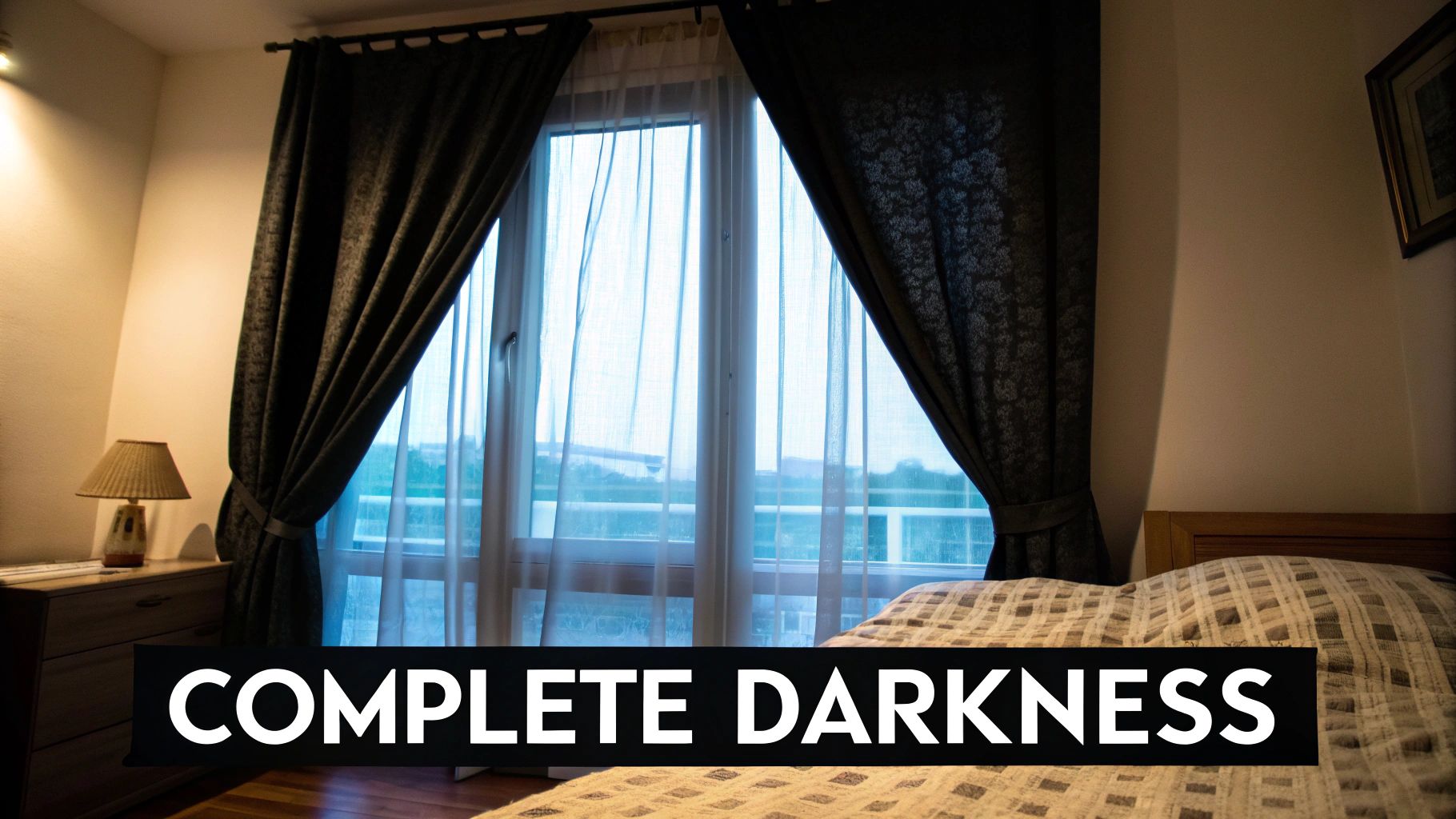
Features:
- 100% light-blocking capability
- Thermal insulating properties
- Sound dampening qualities
- Multiple layer construction
- Available with decorative face fabrics
Pros:
- Creates an optimal sleep environment by eliminating light and reducing noise.
- Reduces energy costs through insulation by minimizing heat transfer.
- Protects furniture and flooring from sun damage by blocking harmful UV rays.
- Provides complete privacy, shielding your interior from outside view.
- Helps with noise reduction, creating a quieter and more relaxing atmosphere.
Cons:
- Heavier than standard curtain fabrics, requiring robust hardware.
- Usually more expensive than traditional curtain materials.
- May require special rods and hardware to maximize light blocking.
- Can be stiff with less natural drape compared to lighter fabrics.
- Often requires professional cleaning due to the specialized construction.
Examples:
- Eclipse Absolute Zero Blackout Curtains
- Pottery Barn Emery Insulated Blackout Curtains
- West Elm Solid Blackout Curtain Panels
For those looking for increased privacy and light control alongside their curtains, consider exploring options like roller blinds. These can offer an additional layer of customization to your window treatments.
Tips for using Blackout Fabric:
- Ensure panels overlap in the middle and extend beyond the window frame for maximum light blockage.
- Use wraparound rods or ceiling-mounted tracks to prevent light leakage at the edges.
- Consider blackout linings for existing curtains as a cost-effective alternative to full blackout panels.
- Choose machine washable options for easier maintenance, if available.
- Install with ceiling-mounted tracks for the most effective light blocking solution.
Popularized By:
- Eclipse
- Roc-lon
- Thermal Shield
- Hotel chains like Marriott and Hilton
- High-end residential designers
Blackout fabric earns its place on this list due to its unparalleled light-blocking and insulating capabilities. Its ability to create a truly dark, quiet, and thermally regulated environment makes it an ideal fabric for curtain in bedrooms, nurseries, media rooms, and any space where light control and privacy are essential. This makes it a particularly good choice for the varied climates experienced across NZ and Australia, from the hot summers to the cooler winters. Its multiple benefits, combined with its increasing availability in stylish designs and textures, make it a valuable option for both residential and commercial applications.
Fabric Types Comparison for Curtains
| Fabric | Core Features/Characteristics | Quality & Experience ★ | Value & Price 💰 | Target Audience 👥 | Unique Selling Points ✨ |
|---|---|---|---|---|---|
| Cotton | Natural, breathable, versatile weights | ★★★★☆ Moderate light filter | 💰 Affordable, eco-friendly | Homeowners, casual interiors | ✨ Soft texture, easy to clean, hypoallergenic |
| Linen | Textured, durable, breathable | ★★★★★ Softer with wash | 💰 Premium priced | Coastal, Scandinavian, elegant designs | ✨ Natural slubs, long-lasting, sustainable |
| Velvet | Plush pile, heavy, rich colors | ★★★★★ Luxurious & insulating | 💰 Higher cost | Formal living, dining, bedrooms | ✨ Sound absorption, dramatic texture |
| Silk | Lightweight, luminous sheen, fine texture | ★★★★★ Elegant & delicate | 💰 Expensive | Upscale, formal interiors | ✨ Natural temperature regulation, sheen |
| Polyester | Durable, wrinkle-resistant, colorfast | ★★★★☆ Practical & low maintenance | 💰 Budget-friendly | Busy households, high-traffic areas | ✨ Easy care, versatile textures |
| Lace | Open weave, decorative, lightweight | ★★★☆☆ Romantic & sheer | 💰 Moderate | Vintage, traditional, layered looks | ✨ Delicate patterns, light diffusion |
| Blackout Fabric | 100% light-blocking, thermal & sound insulation | ★★★★★ Superior performance | 💰 Higher cost | Bedrooms, home theaters, shift workers | ✨ Total darkness, energy saving, privacy |
Crafting Your Dream Interiors with Maak Home
Choosing the right fabric for curtain is a crucial step in creating the perfect ambiance for your space. From the breezy lightness of cotton and linen to the opulent drape of velvet and silk, and from the practicality of polyester to the delicate charm of lace, each fabric offers unique aesthetic and functional benefits. Understanding the properties of each material, including specialized options like blackout fabric, empowers you to make informed decisions that enhance both the beauty and comfort of your interiors. Whether you're aiming for a light and airy feel, a touch of classic elegance, or complete light control, the ideal fabric for curtain awaits. Mastering these fabric choices allows you to control light, privacy, and temperature, ultimately contributing to a more harmonious and enjoyable living or working environment. This knowledge is invaluable for creating spaces that truly reflect your personal style and meet your specific needs, whether you're an interior designer working on a large-scale project or a homeowner looking to refresh a single room.
For discerning clients across New Zealand and Australia seeking exceptional fabric for curtain, Maak Home offers a unique blend of style, sustainability, and bespoke craftsmanship. We provide a wide selection of high-quality, eco-conscious fabrics perfect for creating custom-made curtains that elevate any space. Visit Maak Home today to explore our curated collection and begin crafting your dream interiors with sustainably sourced materials and expert design, all made right here in Aotearoa.





